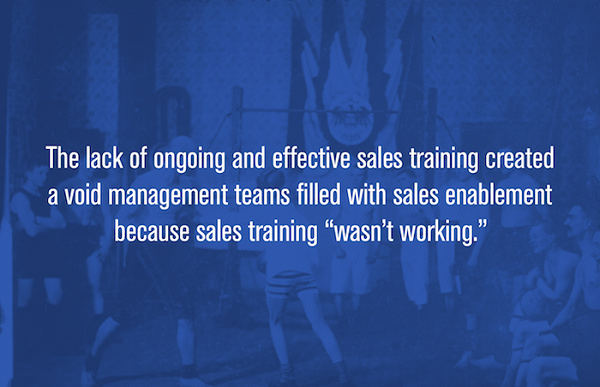ATD Blog
Bridging the Gap from Knowing to Doing in Sales
Thu Feb 26 2015

The Bad News: When sales teams are under-trained and unprepared to use sales enablement tools effectively, firms can spend a lot of time, energy and resources accomplishing very little.
The Good News: A well-designed, current training program within a culture of learning cultivates primed sales reps, willing and eager to learn and use new tools and understand product enhancements.
Anyone who understands sales success knows there is more to it than great tools. But more often than not, when something isn’t working as expected—when sales isn’t selling as fast or as much as we hoped—we start searching for a silver bullet to magically resolve the situation.

But sales enablement tools alone are not the answer. In any discipline “practice makes perfect” and providing ongoing training bridges the gap between initial training/onboarding and on-the-job performance.
On average, we’re spending $5,000 annually, per employee, on sales training. Yet 85 percent of buyers report that meetings with sales people are ineffective. With so much at stake, sales organizations are constantly on the lookout for surefire ways to change behavior, improve sales productivity, and help clients see a clear path to value.
Despite heavy investments, this data shows that sales teams are unprepared to address the needs of buyers: being knowledgeable about the company is just a part of sales training. We’re all guilty of setting (sometimes unrealistic) strategic goals for sales, and when this happens it’s sales management’s responsibility to keep it simple and protect the sales training process.
Sales Management Priorities Must Shift
It’s the responsibility of sales management to meet the need for ongoing, updated training, though it’s clear that some of us are failing. Even though we know sales training should be coordinated, regular, and built for all learning types, this clearly isn’t the norm.
In fact, data from Brainshark's 2014 State of Sales Training: Trends and Challenges reports that only 32 percent of firms describe their current sales training programs as “effective.” Meanwhile, 48 percent of sales training pros say their organization’s sales training content isn’t engaging. Even further, 25 percent say the materials created don’t match sales teams’ needs. All this means that there is significant room for improvement for sales training.
According to Sales Readiness Group, “one way to clarify expectations of everyone involved and specify what is supposed to happen after the training is to \[…\] create a customized “Sales Manager Reinforcement Guide” that outlines the activities and steps the sales manager can take to support the program, and suggest a timeline for completion.”
Change doesn’t happen quickly or easily, but when the existing sales team is successful the rewards are worth the work.
You've Reached ATD Member-only Content
Become an ATD member to continue
Already a member?Sign In
